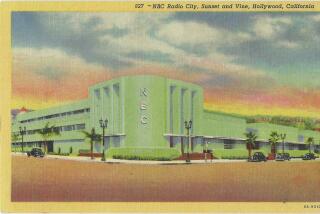William H. Kobin, former KCET president who pulled public TV station out of debt, dies
William H. Kobin, the broadcast journalism pioneer who served as president and chief executive of KCET during its glory days by turning the debt-ridden public television station into an essential educational and cultural institution in Southern California, has died. He was 91.
Kobin died Friday at his Brentwood home of complications from Parkinson’s disease, according to his former communications executive and longtime friend Barbara Goen.
For the record:
9:15 a.m. Jan. 12, 2021In an earlier version of this article, “The Forsyte Saga” was misspelled as “The Forsythe Saga.”
Kobin, who worked in public television for 50 years, served as KCET’s president from 1983 to 1996 and made important contributions to the local station during his tenure. He is credited with “discovering” broadcast legend Bill Moyers — his proudest accomplishment — and putting Tennessee native Huell Howser and the Loud family of Santa Barbara on the small screen in “California’s Gold” and the reality TV series “An American Family,” respectively.
Other notable programs he helped launch included “Puzzle Place,” “Storytime,” “The Astronomers” and the public-affairs program “Life & Times,” all enabled by major commitments and large production grants from local companies and charities.
An Indianapolis native who studied English and psychology at UC Berkeley, Kobin established himself in broadcast journalism as a news producer for CBS News and ABC before leaving network news for the fledgling not-for-profit TV startup NET in New York, a precursor to the PBS system. When he joined KCET-TV Channel 28 in 1983, he turned a poorly managed station with a $3.6 million debt into one of the country’s largest public television stations.
“I read the newspaper articles on an airplane coming west and almost jumped out of the plane,” Kobin told Goen. “When I saw the financial statements, I thought ‘Where are the real statements?’”
Ruddy-cheeked and wearing a broad grin, William H.
Kobin, who prided himself on topical and sometimes controversial news programs, was also contending with larger stations that were scrambling to find new sources of revenue and ways to distinguish themselves from scores of new television channels, many of which were biting into traditional PBS program genres. He then nudged KCET to show enterprise, believing that “the more broad-based the sources of support are, the better off a public institution like KCET is.”
By 1986, four years after staring bankruptcy in the face, the board of directors at KCET Channel 28 was able to pay off its debts four months ahead of schedule. At the worst of its financial crisis in 1982, the station was $5.5 million in the red, forcing it to make drastic reductions in personnel and programming and to consider selling its 4 1/2-acre studios in Hollywood, according to previous Times reporting.
His best days at the station involved the receipt of production grants, he told The Times. His worst: sparring with the Catholic Church and former Los Angeles Archbishop Roger Mahony over the 1991 documentary “Stop the Church,” which chronicled AIDS activists disrupting a Mass in New York’s St. Patrick’s Cathedral. Airing the documentary led to calls of boycotting the station.
“It was an experience, the worst experience I’ve ever had in broadcasting,” he told The Times. “It was being called a bigot ... just having people think that I personally was a bigot. Having the cardinal [Mahony] hold a news conference and telling Catholics to stop supporting KCET. Having people think that I was anti-Catholic. And having my board at the time split on the wisdom of having run it.”
The issue resolved over time, but Kobin held his position that “airing the film was the correct decision journalistically.” In 2013, Mahony was relieved of all public duties over his mishandling of clergy sex abuse of children decades ago.
When he retired in 1996, he left the station as the third-largest public television station in the U.S., with a doubled weekly audience of nearly 3 million households and an annual budget of $43 million — three times larger than it was upon his arrival, according to KCET.
He was succeeded by veteran network TV executive Albert D. “Al” Jerome, then rejoined KCET in 2011 as a member of the station’s board of directors.
Kobin worked with stalwart news veterans Edward R. Murrow, Charles Collingwood, Walter Cronkite, Howard K. Smith, Harry Reasoner, Andy Rooney and Eric Sevareid, among others.
“I worked with the best,” Kobin said. “I learned never to call a news program a ‘show’ — that was for those entertainment guys over there. The news division did serious programs, and we weren’t allowed to forget it.”
Moyers, President Lyndon B. Johnson’s former chief of staff and press secretary, was a young newspaper publisher when Kobin persuaded him to try television. Moyers’ first series, “This Week,” was the beginning of his long, illustrious career at PBS.
“He was instantly excellent on-air and the series was a considerable success — to everyone but Bill,” Kobin had said. “Shortly after the season ended, I received a letter from him apologizing for letting me down and saying he really didn’t think he was right for television and should leave the series. Fortunately, after much discussion, he didn’t.”
After clawing for seven years over the same turf, Southern California’s two large public television stations — KCET and KOCE — are merging to become a stronger voice in local broadcasting.
In 1963, Kobin became the head of public affairs programming at National Educational Television (NET), then a center for national production and distribution funded by the Ford Foundation, ultimately becoming the vice president of programming.
He launched “Black Journal” in 1967. It was the first regularly scheduled series on network television handled by Black producers. The program incited a firestorm of protest for its candid discussions of racial disparities and the plight of urban communities. He also brought the distinctive British series “The Forsyte Saga” and “Civilization” to American audiences and launched public TV’s hit series “The Adams Chronicles.”
In 1977, Kobin became president of KTCA/KTCI in Minneapolis-St. Paul, known as Twin Cities Public Television, and worked there for six years. He was also vice president at Children’s Television Workshop in the 1970s. That workshop ultimately became Sesame Workshop, the nonprofit behind “Sesame Street.”
Kobin is survived by his wife, Frances Goodman-Kobin; four children, Melissa, Matt, Chris and Jenny; six grandchildren, six great-grandchildren, and two stepdaughters, Jonna and Jessica.
More to Read
Start your day right
Sign up for Essential California for the L.A. Times biggest news, features and recommendations in your inbox six days a week.
You may occasionally receive promotional content from the Los Angeles Times.







